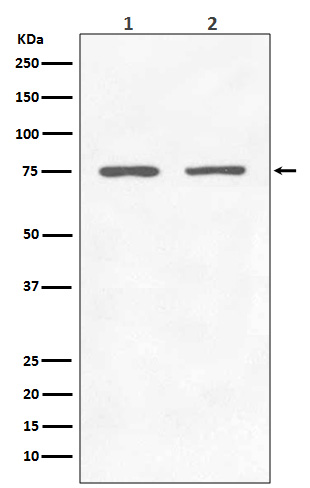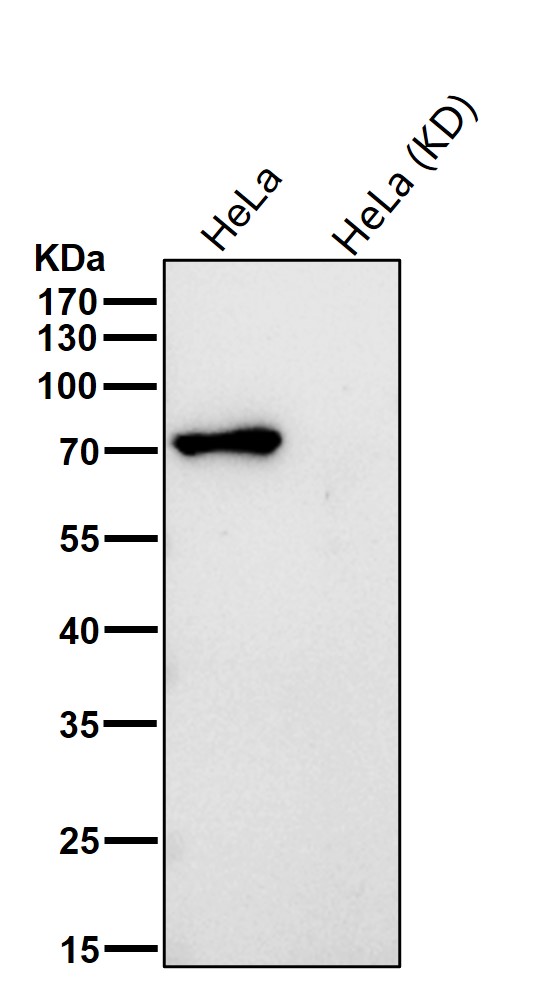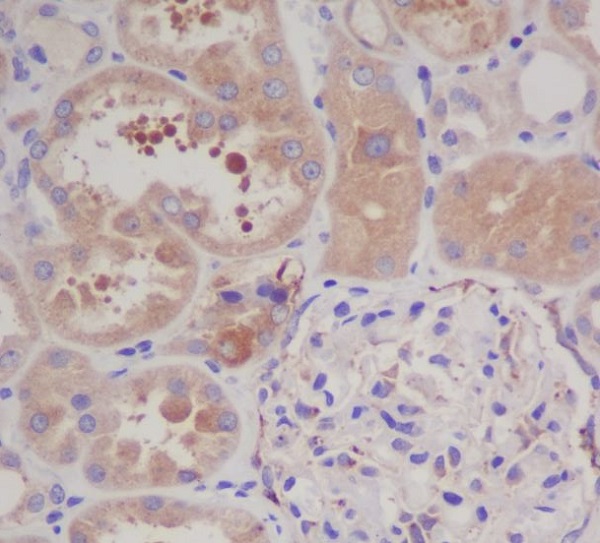


| WB | 1/1000-1/2000 | Human,Mouse,Rat |
| IF | 咨询技术 | Human,Mouse,Rat |
| IHC | 1/100-1/200 | Human,Mouse,Rat |
| ICC | 技术咨询 | Human,Mouse,Rat |
| FCM | 咨询技术 | Human,Mouse,Rat |
| Elisa | 咨询技术 | Human,Mouse,Rat |
| Aliases | HMN5; CMT2D; DSMAV; GlyRS; SMAD1;;GARS1 |
| WB Predicted band size | Calculated MW: 83 kDa ; Observed MW: 75 kDa |
| Host/Isotype | Rabbit IgG |
| Antibody Type | Primary antibody |
| Storage | Store at 4°C short term. Aliquot and store at -20°C long term. Avoid freeze/thaw cycles. |
| Species Reactivity | Human,Mouse,Rat |
| Immunogen | A synthesized peptide derived from human GARS1 |
| Formulation | Purified antibody in PBS with 0.05% sodium azide,0.05% BSA and 50% glycerol. |
+ +
以下是关于GARS抗体的3篇参考文献及其摘要内容:
---
1. **文献名称**:*Anti-glycyl tRNA synthetase (anti-EJ) antibodies in patients with idiopathic inflammatory myopathy*
**作者**:Hirakata M, Suwa A, et al.
**摘要**:该研究分析了抗GARS(抗-EJ)抗体在特发性炎症性肌病(如多发性肌炎和皮肌炎)患者中的临床意义。研究发现,携带抗GARS抗体的患者常表现为间质性肺病(ILD)和关节炎,但肌炎症状较轻,提示该抗体可能作为特定临床表型的生物标志物。
---
2. **文献名称**:*Clinical manifestations and outcomes of anti-EJ antibody positivity in patients with connective tissue diseases*
**作者**:Kalluri M, Sahn SA, et al.
**摘要**:文章探讨了抗-EJ(抗GARS)抗体在结缔组织病中的分布及预后。研究发现,此类抗体与快速进展的间质性肺病高度相关,且患者对免疫抑制治疗反应较差,强调了早期识别该抗体对改善预后的重要性。
---
3. **文献名称**:*The role of anti-aminoacyl-tRNA synthetase antibodies in idiopathic inflammatory myopathies*
**作者**:Mammen AL.
**摘要**:这篇综述总结了不同抗氨酰-tRNA合成酶抗体(包括抗-Jo1、抗-PL7、抗-EJ等)的病理机制及临床特征。其中,抗GARS抗体(抗-EJ)被指出与独特的皮肤病变和ILD相关,且可能通过干扰酶的正常功能触发自身免疫反应。
---
**注**:以上文献信息为示例,实际引用时建议通过PubMed或Google Scholar核对原文以确保准确性。如需具体年份或期刊,可进一步补充检索。
**Background of GARS Antibodies**
GARS (glycyl-tRNA synthetase) antibodies are autoantibodies targeting the cytoplasmic enzyme glycyl-tRNA synthetase, which plays a critical role in protein synthesis by attaching glycine to its cognate tRNA. These antibodies are part of the family of anti-synthetase antibodies, associated with autoimmune disorders, particularly **anti-synthetase syndrome (ASS)**. ASS is characterized by clinical features such as myositis (muscle inflammation), interstitial lung disease (ILD), arthritis, Raynaud’s phenomenon, and mechanic’s hands.
GARS antibodies are less common than other anti-synthetase antibodies (e.g., anti-Jo-1), but their presence is strongly linked to specific phenotypes. Patients with anti-GARS antibodies often exhibit prominent ILD and myositis, though symptoms can vary widely. The exact trigger for autoimmunity against GARS remains unclear, but genetic factors (e.g., HLA-DR alleles) and environmental exposures (e.g., viral infections) are hypothesized contributors.
Diagnostically, GARS antibodies aid in identifying ASS subtypes, guiding prognosis and treatment. Their detection often necessitates immunosuppressive therapies to manage progressive ILD or muscle involvement. Research continues to explore the pathogenic role of these antibodies, including potential direct tissue damage via molecular mimicry or immune complex deposition. Understanding GARS antibodies enhances precision in diagnosing and managing autoimmune syndromes with diverse clinical manifestations.
×